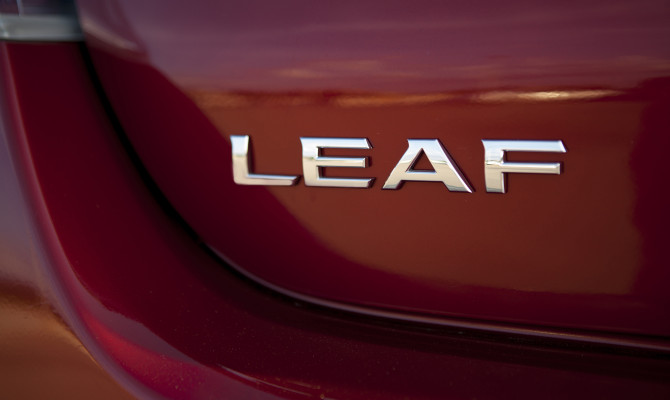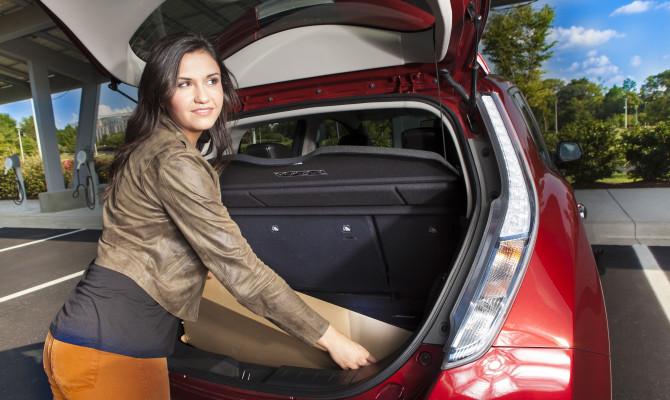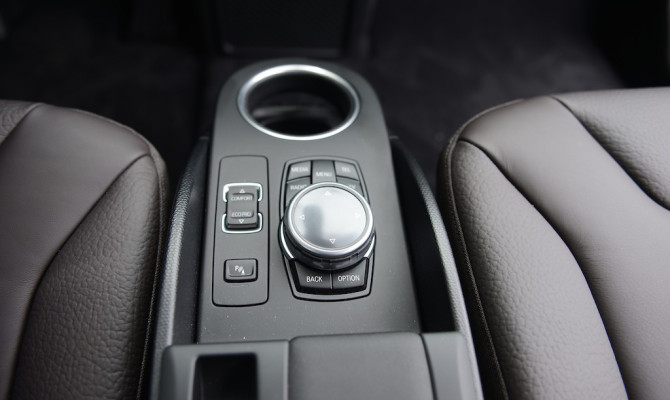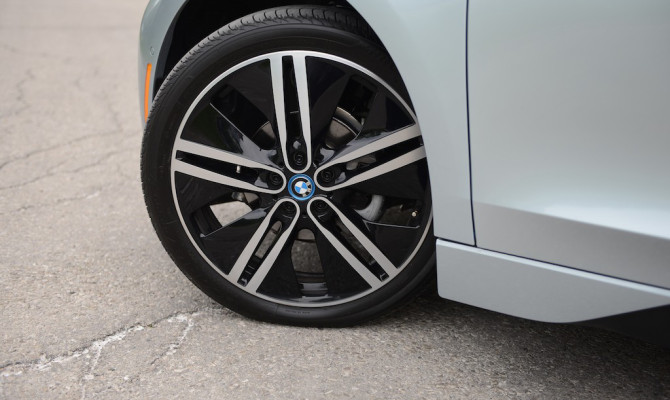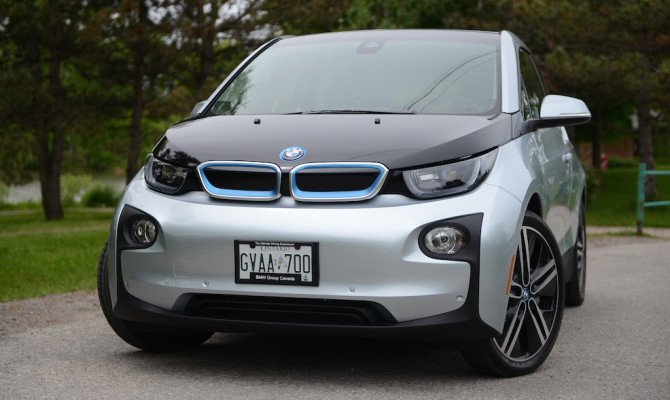Surrey resident Linda Webster is now the proud owner of a Nissan LEAF, as the winner of our Plug-In to Win contest.
“I’m so excited because I’ve taken an interest in electric cars for some time but never dreamed I would own one,” said Linda, as she clutched the keys outside of Jonker Nissan, in Langley, last week.
“I’m going to really enjoy seeing how much I can get out of each charge… I’ll let you know!”
With a range of in excess of 120 kilometres on a full charge, Linda figures she will be able to visit friends and family in Vancouver.
British Columbia’s SCRAP-IT Program kindly supplied us with the eco-friendly sedan for the contest, which attracted a record-breaking 34,558 entries, the biggest Black Press contest ever. The five-seater car was displayed at the SCRAP-IT booth at the recent Vancouver International Auto Show, where it attracted thousands of admiring looks.
SCRAP-IT announced its new incentive program in Driveway just before the show. It’s offering a $3,000 rebate for electric car purchasers if they scrap a 2000 or older vehicle. This is in addition to the newly announced provincial government program.
SCRAP-IT Program CEO Dennis Rogoza revealed: “Vehicles model 2000 or older emit up to 60 times more emissions than later models and electric vehicles have even much lower emissions.”
Qualifying electric vehicles are listed on the SCRAP-IT.ca website.
“With the expansion this year’s show underwent, the Vancouver show is moving into the big leagues.”
(more…)
If you would like to plug in an all-electric Nissan LEAF at your home, this weekend is the last chance you will have to get one for nothing!
British Columbia’s SCRAP-IT Program kindly supplied us with one of the eco-friendly sedans as a prize in our Plug-In to Win Contest, which closes at midnight on Sunday (see the link or below for entry details). The winner will be announced online next week and Driveway will feature an interview with the lucky winner in an upcoming edition.
SCRAP-IT announced its new incentive program here last week, which offers a $3,000 rebate for electric car purchasers if they scrap a 2000 or older vehicle. This is in addition to the newly announced provincial government program detailed in our main story today.
The LEAF will be on display at the SCRAP-IT booth throughout this weekend at the Vancouver International Auto Show, in the Vancouver Convention Centre West. Qualifying electric vehicles for the organization’s incentive are listed on the SCRAP-IT.ca website. Take a look because some of them, plus vehicles qualifying under the additional government program, will be at the show to view and some made available there for test drives outside.
For information on electric vehicles and charging systems and infrastructure visit Plug-In BC at: http://pluginbc.ca/
For details of the Clean Energy Vehicle incentive program visit: www.cevforbc.ca
Driveway’s Alexandra Straub will pilot an all-electric Nissan LEAF in the annual AJAC Eco-Run this week.
The all-electric sedan, which is also the prize car provided by the Scrap-It program for our Plug-In to Win contest, will glide silently from the Vancouver International Auto Show in downtown Vancouver on Wednesday. The route, devised by the Automobile Journalists Association of Canada, will then take the participating 19 eco-friendly vehicles to Victoria via the Nanaimo ferry. On Thursday, the vehicles will be put through their paces on a handling course in Langford to see how versatile they are. The EcoRun concludes that evening in Vancouver.
In addition to pure electric vehicles, the Eco-Run includes plug-in and conventional hybrids, as well as vehicles powered by hydrogen fuel cells, diesel-fuelled powertrains and highly efficient gasoline options.
There’s no limit to the size of vehicle showcased, as they range from subcompacts to pickup trucks. The participants include the 2015 Hyundai Tucson Fuel Cell, 2015 Jeep Grand Cherokee EcoDiesel, 2015 Kia Soul EV, 2015 Ford Focus 1.0-litre, 2015 Acura RLX Sport Hybrid and the 2015 Chevy Volt.
The purpose of the event is to inform consumers of these alternative options. These new vehicles are driven in real-world road conditions in order to fully test for fuel efficiency and the reduction of carbon dioxide emissions.
The Nissan LEAF miraculously cut a journey in half this week.
I’ll explain. I took the plug-in sedan on a 43-kilometre trip from Vancouver to Driveway HQ, on 152nd Street, in Surrey. When I set out, the screen display showed that I could drive emission-free for 146 kilometres.
Now, I could have taken off like an F1 racecar and street raced all the way, because electric power offers instant tire squealing torque if you press the pedal to the metal. But that’s not me. Spurred by my ecofriendly driving the previous day, the clever car had decided earlier in the day that I could do 156 kilometres on a full charge. Not boasting but that’s easily more than 20 kilometres better than the average driver can expect to achieve. Okay, maybe my head is swelling.
The big 1-4-6 winked at me. I threw the stick into ECO mode and with two flicks of the wrist pushed it into the enhanced B-mode, which puts the braking power regeneration into overdrive, so to speak.
I glided silently down the road, picking up pace ever so gradually in the busy city traffic. Rolling down the hills to Marpole, I could feel the juice from the brakes topping up that battery.
On the freeway, I hit the posted speed limit and 40 minutes later pulled into HQ. The display flashed 126. I had covered 43 klicks with the power required to move the car just 20! Such fun.
Next week: more on the joy of driving electric.
“The fuel efficiency of the four-door, five-seat LEAF is calculated at the gas equivalent of about 2.0 L/100 kms with a range of around 120 kms on a full charge.”
(more…)
Electric car buyers need to know if they can live with the limits of the electric cars’ range or if they want the flexibility to extend the range with an on-board generator…
This story could be obsolete in a month as automakers add electrification to existing models and introduce all new models, at an incredible rate.
The market for electric cars or plug-in hybrids is very small but it’s growing. The success of Tesla’s Model S has shot its stock price into the stratosphere, as investors bet on that company’s emergence as the electric car and technology leader. The stock price should really reflect the cars sold, as Tesla can only make about 20,000-25,000 cars annually for a worldwide market.
The Market
Green Car Report recently published a sales report on all electrics sold in Canada for the first six months of the year. The list of vehicles sold is compiled from companies’ self-reporting but Ford’s data is missing. This Green Car Report estimates that Ford’s numbers will push overall electric sales to 2,200 for the first half of the year, a 50 per cent improvement over a year ago. What we do get is a good snapshot of the market. With only 1,941 electrics officially counted, amounts to only 0.21 per cent of the overall Canadian marketplace. (Canadians are on track to buy almost 1.7 million vehicles this year.) So these are tiny but important numbers and the trend is higher. The clear winner isn’t the Tesla at all; in fact it is in third place behind the Chevy Volt and Nissan LEAF. Chevy sold 831 Volts up to July with Nissan selling 462 LEAFs and Tesla moving 290 Model S cars. The Smart Full Electric Drive comes in fourth with 163 cars sold and in its first month of sales (June) the BMW i3 looks good with 50 units sold.
Not all electric cars are the same
What many people don’t realize is the complexity of the electric car market. I look at it this way, if the car can be plugged into an outlet; it is at least partially electrified. There are pure electric cars like the Nissan LEAF, Tesla Model S, Smart Electric, Mitsubishi i-MiEV and BMW’s new i3 – all of these use just electricity to propel the car. Then there are electric cars that have an onboard generator, should the range of the electric pack limit driver’s intentions. The Chevy Volt, Cadillac ELR, the Toyota Prius Plug-In and the BMW i3 are, or can be equipped, with a gasoline engine to either drive the wheels or charge the battery. This is one area where the Chevy Volt wins. With roughly a 65 km range on pure electricity and a small generator on board to extend the range indefinitely, this car makes a lot of sense. This is why the BMW i3 has an optional generator for $3,000 to extend the range of that model. But if the buyer chooses this option, the range of pure electric drive is limited because of the added weight of the car. Electric car buyers need to know if they can live with the limits of the electric cars range or want the flexibility to extend the range with an on-board generator.
What is still to come?
We are living in interesting times.
More and more electric cars are being added, not to meet the demand but to meet regulatory requirements. For the model year 2016, the United States has a new cooperate average fuel economy (CAFE) standard that has each manufacturer trying to hit 35.5 mpg average across their fleet, including small trucks. This isn’t doable with the current internal combustion engine technology, so these manufacturers are looking to electrification as the answer. Even though more and more electric versions will arrive, don’t expect them to sell. In fact, most car companies don’t expect them to sell at all; they just want the mpg credit towards the new regulations. This might sound cynical but watch how many electric cars will arrive, especially for the 2016 model year, and how many you will actually see on the road. Most are built at a loss, to offset thirstier, gas-loving machines.
Verdict
Even though electric car sales are very small and many new models will go unnoticed, the trend to electrification is here. With markets like China mandating a percentage of electric cars to offset its horrific pollution, will help move the numbers of electric vehicles worldwide. This, along with steady adoption rates here in North America will help promote better charging infrastructure. Another factor is the price to own an electric car. The Smart Electric is priced at $27,000 making it the least expensive full electric car. With Nissan hacking its price on the LEAF to just over $31,000 and the Volt starting at roughly $35,000, these cars are more affordable than ever. I think the BMW i3 is very attractive for $45,000 because it is a luxury brand at an attainable price. The real showstopper will be the Tesla Model III that they hope to sell for US$35,000 with more than 400km of electric range when it is introduced in 2017.
Even though Tesla has the sex appeal going right now, don’t count out the other mainstream manufacturers with decades, if not centuries of auto making knowhow, to take on the challenge.
I like the use of technologies to avoid crashes but I can’t foresee a time when I would want to commit to fully-autonomous driving…
It is pouring with rain so the car drops you off at the supermarket entrance and heads off on its own to find a parking spot way the heck and yonder at the other end of the mall.
When you have finished your Big Shop for the week, it is still raining cats, dogs and frogs so you hit the button on the key fob. The car returns from wherever it was and you load up with nary a drop of the wet stuff falling on your head.
Futuristic fantasy?
Well, getting your hands on the key fob to an autonomous drive car may mean a wait until 2020, when Nissan plans to begin selling that feature in multiple vehicles. However, a car capable of doing the task described in a driverless mode is here in the now.
Nissan granted yours truly the opportunity recently to take a spin in a driverless electric-powered LEAF. Actually, the word spin doesn’t truly describe what was a very smooth and controlled ride around a course loaded with obstacles, traffic lights turning red, cars changing lanes unexpectedly and automated pedestrians wondering out in front of us – if ‘me’ and the car counts as an ‘us’.
The LEAF looked like any normal edition but was loaded with 360-degree cameras, laser scanners, radar and other ‘electrickery’, as a TV character called Catweazle once described the workings of a light bulb. I felt like that character from my childhood, who incidentally was a caveman hurled through time into the 1960s.
The car pulled away smoothly, stopped at those red lights and signalled turns, a sequence of manouevres rarely witnessed on our roads when there are humans at the wheel. It slowed when a car driven by a human changed lanes ahead of us on the off-road circuit. I would have hit the phoney ped that bounded out from the curb but not this ghost driver that took instantaneous evasive action.
My drive was on an airport-based circuit away from the real world, while over in Japan Nissan has conducted some demonstrations on freeways. By the end of this year, a dedicated track featuring real townscapes – masonry, not model buildings – will be ready. It will enable testers to push the vehicles impossible to carry out on public roads to ensure the technology is safe.
When the car is available for real world driving, a combination of GPS navigation and a tablet-style screen will enable the non-driving driver to direct the car to work, home, play or park with precision. You will be able to drive your favourite routes and it will map and record the preferences for future trips.
The mock supermarket-shopping demo was the most enjoyable part of my experience because driving around full parking lots looking for a space is not my favourite pastime. That said, I’m not thrilled at the thought of fun being removed from my daily driving. I like the use of technologies to avoid crashes but I can’t foresee a time when I would want to commit to fully-autonomous driving. Not because I don’t trust the technology but because I enjoy the challenges thrown up my daily drive.
And I have this fear that many will allow their skills to diminish but just relying on technology to get them out of trouble. Do you agree or am I caveman like Catweazle?
Recent Comments
- { Enjoyed your Forest of Bowland in the BMW X5M, particularly the photo of the BMW in front of the main part of Stonyhurst College where... }
- { Bantam designed the Jeep, not Willy's or Ford. The American military gave the original Bantam prototype to Willys and Ford to copy. There is plenty... }
- { All Escalades come with a 6.2-lilter V8 engine that produces 420 horsepower. A six-speed automatic is the only transmission offered and drives the rear wheels.... }
- { Alexandra is an excellent journalist. }
Popular Posts
- Journey to a ‘Sparkling’ Luxury Okanagan Resort “Four lucky readers will put a Dodge Journey’s weekend-...
- The Need For Speed: Hike Those Highway Limits More than half of those polled believe the province sho...
- Drives-U-Crazy… Erratic drivers. An early morning drive from Kelowna to Vancouver is nor...
- Readers Respond: The Pros and Cons of Increasing B.C. Speed Limits Increasing the speed limits will only increase risk to...
- Honda CR-V Review: The Compact Crossover To Get Things Done The CRV is a very stylish and aerodynamic crossover veh...




